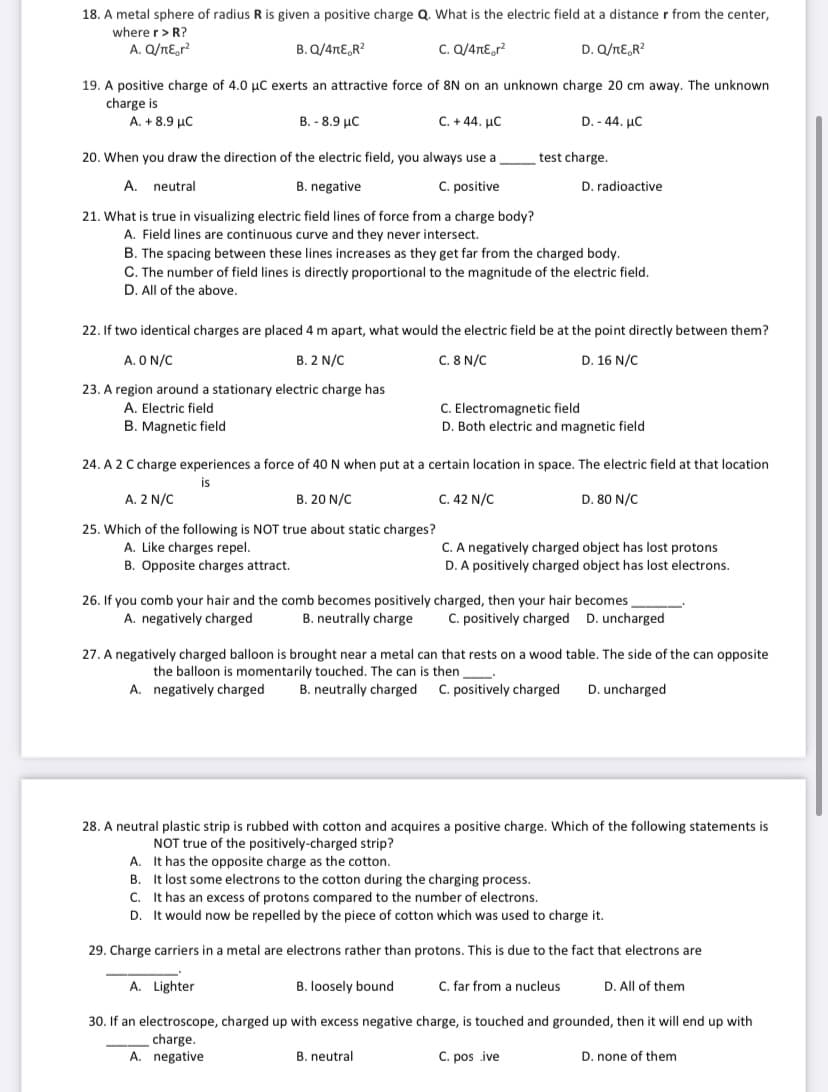18. A metal sphere of radius R is given a positive charge Q. What is the electric field at a distance r from the center, where r> R? A. Q/nE,r? B. Q/4nE,R? C. Q/4nE,r? D. Q/nE,R? 19. A positive charge of 4.0 µC exerts an attractive force of 8N on an unknown charge 20 cm away. The unknown charge is A.+ 8.9 με B.-8.9 με C. + 44. µC D.- 44 με 20. When you draw the direction of the electric field, you always use a test charge. A. neutral B. negative C. positive D. radioactive
18. A metal sphere of radius R is given a positive charge Q. What is the electric field at a distance r from the center, where r> R? A. Q/nE,r? B. Q/4nE,R? C. Q/4nE,r? D. Q/nE,R? 19. A positive charge of 4.0 µC exerts an attractive force of 8N on an unknown charge 20 cm away. The unknown charge is A.+ 8.9 με B.-8.9 με C. + 44. µC D.- 44 με 20. When you draw the direction of the electric field, you always use a test charge. A. neutral B. negative C. positive D. radioactive
College Physics
1st Edition
ISBN:9781938168000
Author:Paul Peter Urone, Roger Hinrichs
Publisher:Paul Peter Urone, Roger Hinrichs
Chapter18: Electric Charge And Electric Field
Section: Chapter Questions
Problem 54PE: Earth has a net charge that produces an electric field of approximately 150 N/C downward at its...
Related questions
Question

Transcribed Image Text:18. A metal sphere of radius R is given a positive charge Q. What is the electric field at a distance r from the center,
where r> R?
A. Q/nE,r?
B. Q/4nE,R?
C. Q/4nEor?
D. Q/nE,R?
19. A positive charge of 4.0 µC exerts an attractive force of 8N on an unknown charge 20 cm away. The unknown
charge is
A. + 8.9 µC
B. - 8.9 µC
C. +44. µC
D. - 44. µC
20. When you draw the direction of the electric field, you always use a
test charge.
A. neutral
B. negative
C. positive
D. radioactive
21. What is true in visualizing electric field lines of force from a charge body?
A. Field lines are continuous curve and they never intersect.
B. The spacing between these lines increases as they get far from the charged body.
C. The number of field lines is directly proportional to the magnitude of the electric field.
D. All of the above.
22. If two identical charges are placed 4 m apart, what would the electric field be at the point directly between them?
A. O N/C
B. 2 N/C
C. 8 N/C
D. 16 N/C
23. A region around a stationary electric charge has
C. Electromagnetic field
D. Both electric and magnetic field
A. Electric field
B. Magnetic field
24. A 2 C charge experiences a force of 40 N when put at a certain location in space. The electric field at that location
is
A. 2 N/C
B. 20 N/C
C. 42 N/C
D. 80 N/C
25. Which of the following is NOT true about static charges?
A. Like charges repel.
B. Opposite charges attract.
C. A negatively charged object has lost protons
D. A positively charged object has lost electrons.
26. If you comb your hair and the comb becomes positively charged, then your hair becomes
B. neutrally charge
C. positively charged D. uncharged
A. negatively charged
27. A negatively charged balloon is brought near a metal can that rests on a wood table. The side of the can opposite
the balloon is momentarily touched. The can is then
A. negatively charged
B. neutrally charged
C. positively charged
D. uncharged
28. A neutral plastic strip is rubbed with cotton and acquires a positive charge. Which of the following statements is
NOT true of the positively-charged strip?
A. It has the opposite charge as the cotton.
B. It lost some electrons to the cotton during the charging process.
C. It has an excess of protons compared to the number of electrons.
D. It would now be repelled by the piece of cotton which was used to charge it.
29. Charge carriers in a metal are electrons rather than protons. This is due to the fact that electrons are
A. Lighter
B. loosely bound
C. far from a nucleus
D. All of them
30. If an electroscope, charged up with excess negative charge, is touched and grounded, then it will end up with
charge.
A. negative
B. neutral
C. pos ive
D. none of them
Expert Solution
This question has been solved!
Explore an expertly crafted, step-by-step solution for a thorough understanding of key concepts.
Step by step
Solved in 2 steps with 2 images

Knowledge Booster
Learn more about
Need a deep-dive on the concept behind this application? Look no further. Learn more about this topic, physics and related others by exploring similar questions and additional content below.Recommended textbooks for you

College Physics
Physics
ISBN:
9781938168000
Author:
Paul Peter Urone, Roger Hinrichs
Publisher:
OpenStax College


Physics for Scientists and Engineers with Modern …
Physics
ISBN:
9781337553292
Author:
Raymond A. Serway, John W. Jewett
Publisher:
Cengage Learning

College Physics
Physics
ISBN:
9781938168000
Author:
Paul Peter Urone, Roger Hinrichs
Publisher:
OpenStax College


Physics for Scientists and Engineers with Modern …
Physics
ISBN:
9781337553292
Author:
Raymond A. Serway, John W. Jewett
Publisher:
Cengage Learning

Physics for Scientists and Engineers
Physics
ISBN:
9781337553278
Author:
Raymond A. Serway, John W. Jewett
Publisher:
Cengage Learning

College Physics
Physics
ISBN:
9781305952300
Author:
Raymond A. Serway, Chris Vuille
Publisher:
Cengage Learning

Physics for Scientists and Engineers, Technology …
Physics
ISBN:
9781305116399
Author:
Raymond A. Serway, John W. Jewett
Publisher:
Cengage Learning